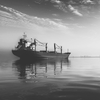When trawler Cape Horn left Bellingham Bay Shipyard in Washington for the January 20, 1999 trawl opening in the Bering Sea fishing grounds, she carried nearly 400 gallons of fresh paint on the outside and a pair of new Cummins KTA38 main engines inside her hull.
Replacing a pair of 900-hp, 16-cylinder two-cycle engines, the new 12-cylinder engines are rated at 1,000 hp. While these particular engines can deliver 1,200 hp, the owners, a Danish consortium, were able to keep the original Twin Disc 540 gears with their 7:1 ratio by having the engines derated.
Although an adapter was available to fit the gear housing to the new engines, they opted to reduce torsional vibration by installing Centraflex flexible couplings. New 29-ft. by seven-in. stainless steel shafts and bearings were installed as well as new props in the kort type 19 nozzles that were added. Due to space limitations under the hull and the fittings of the nozzles, the new 81.5 x 80.75 in. four-blade Kaplan-style props are slightly smaller in diameter than the 84 x 64 in. four blade originals but with significantly more pitch.
"We wanted more power to enable us to punch through the seas when fishing in rough weather," says fishing master and part owner Karsten Hjelm, "With the addition of the nozzles and increased horsepower we expect to increase the bollard pull from about 24 tons with the old engines to 31.5 with the new engines."
The boat's free running speed increased from nine to nearly 11 knots with an anticipated 20 percent fuel savings. The vessel will tow a trawl with 500 eight-in .meshes and a 160-ft. rope and 8.7 square meter Danish-built Perfect trawl doors.
On the fishing deck, a shelter has been added on the port side to cover the pair of new electronic driven hydraulic crane winch drives. A forward gantry has been added over the end of the main deck house. In the interior of the pilot house has been totally refinished with new consoled designed to accommodate existing and additional electronics.
Built in 1983 at Halter's Mississippi shipyard, the 156 x 37 ft. vessel has freezer hold capacity for 220 tons of processed fish. Her fishing crew of five supplies the onboard factory crew of 22, who produce 35 to 40 tons of processed fish per day.
An interesting feature on the vessel is the Alfa Laval JVC 26C80 watermaker that will function with hot water from the starboard main engine's fresh water cooling system. Utilizing a specialized manifold designed and fabricated at Bellingham Bay Shipyards, where all work was carried out, hot water from the main engine will pass through the water maker where its head will vaporized raw salt water in a vacuum at temperatures significantly less than 100 degrees Celsius.
With a potential, under ideal conditions, of producing 9,000 gal. per day, the owners expect more like 3,000 gal. per day in cold Alaskan waters. This will provide more than enough water for crew needs as well as adequate water for glazing frozen fish products.
Subscribe for
Maritime Reporter E-News
Maritime Reporter E-News is the maritime industry's largest circulation and most authoritative ENews Service, delivered to your Email five times per week










